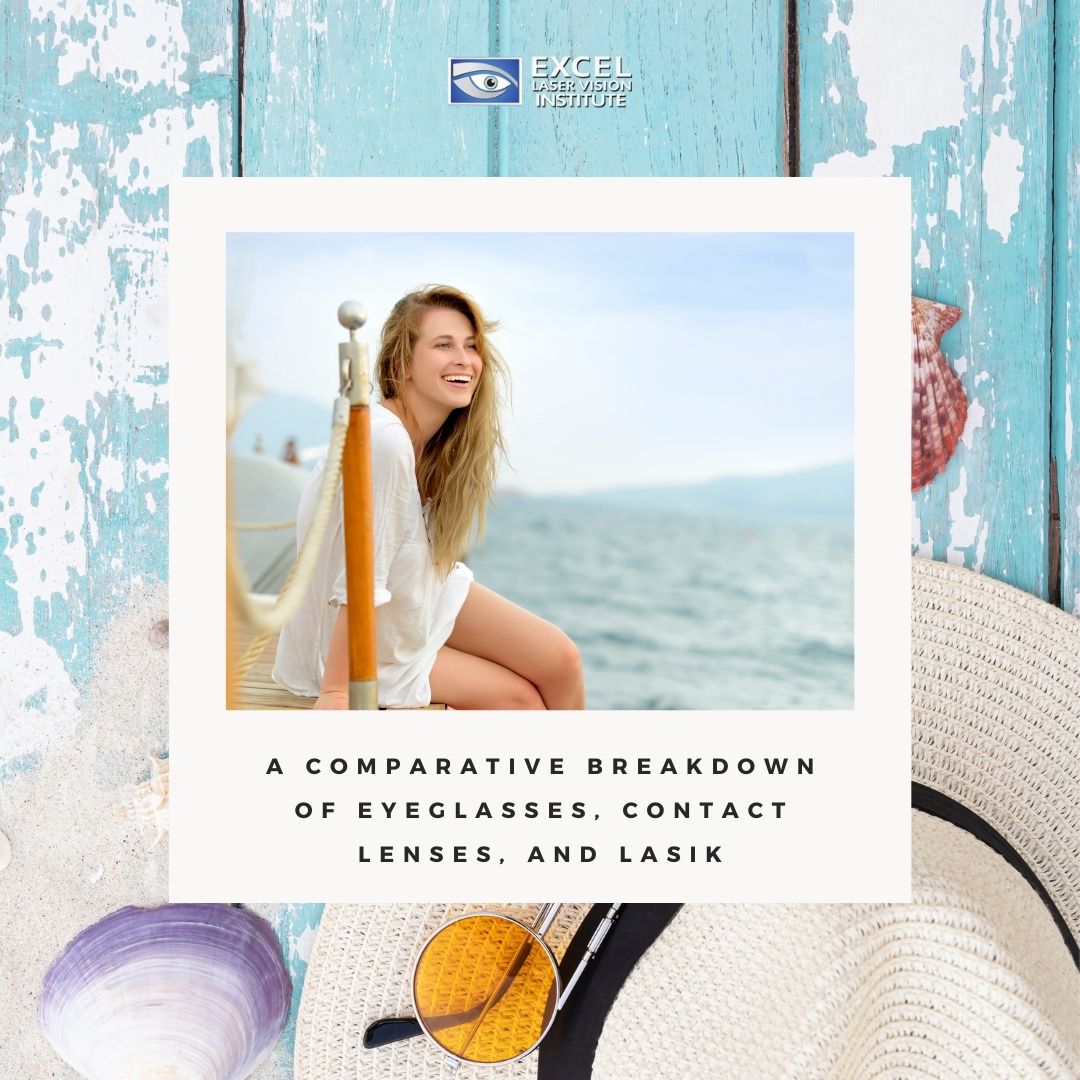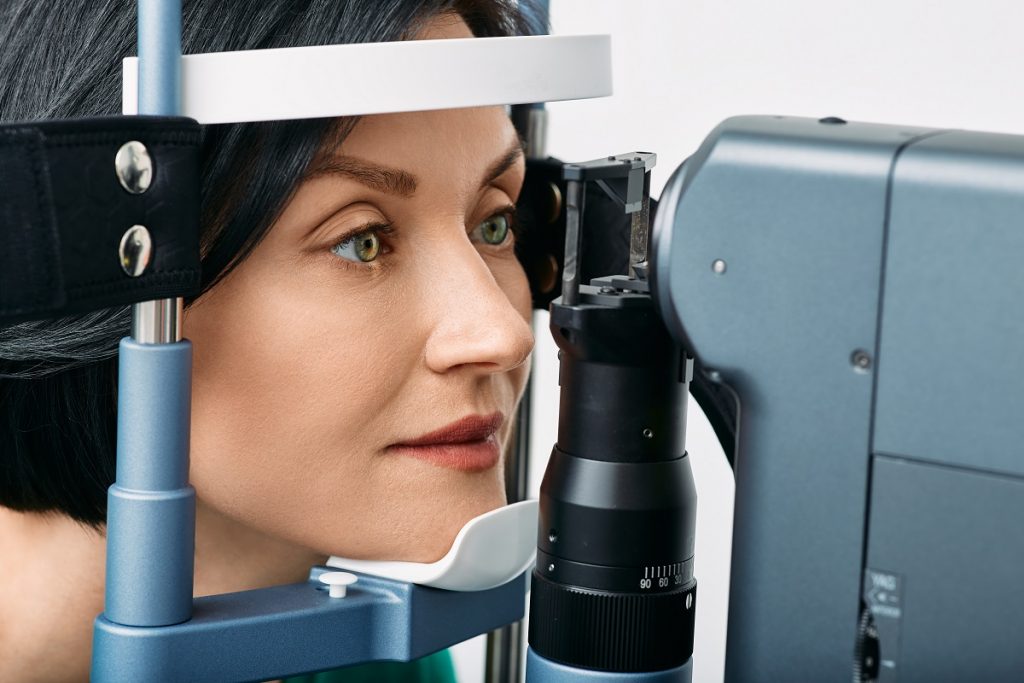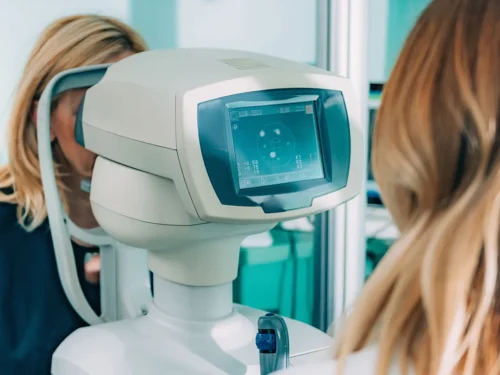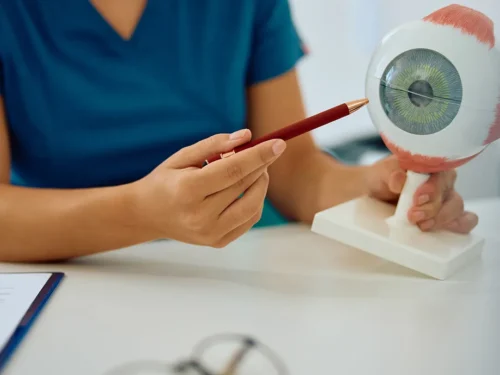
Advantages and Disadvantages
According to the World Health Organization (WHO), there are at least 2.2 billion in the world with some type of vision impairment. In most cases, vision impairment either could have been prevented easily or has not yet been addressed with corrective measures like eyeglasses, contact lenses, or LASIK.
In this article, we’ll be looking at the different ways to correct eyesight and their various advantages and disadvantages.
Eyeglasses
Wearing eyeglasses is the easiest way to correct your vision. In fact, some people even wear eyeglasses despite not having any vision problems—it’s seen as a fashion statement that can complement your outfit, make you look smarter and more knowledgeable, and improve your look overall. There are tons of eyeglasses designs with different shapes, styles, and colors to choose from.
Eyeglasses are also pretty nifty because they’re easy to maintain. If the lenses are dirty, you can wipe them with a clean cloth or even the bottom of your T-shirt. They’re also easy to put on and remove, making it easy to switch to a different pair or take them off right before heading to bed.
The disadvantage to a good old pair of eyeglasses is their inconvenience. You can’t wear them for every occasion—you can’t swim in a pool or ride a roller coaster, for example, and if you get them wet or foggy, you’d need to take them off and clean them before you can see properly again. What’s more, you can’t wear certain things like sunglasses or goggles because of it too.
Additionally, eyeglasses are clunky and ridiculously easy to lose. As a four-eyed person, I can’t remember how many times I’ve acted like Velma in Scooby-Doo and gone out of commission due to losing my eyeglasses. And it’s not like you can slip them into your bag whenever you need to either, as the lenses get scratched and damaged easily.
So, while eyeglasses are certainly quirky and easy to wear, they definitely leave a lot to be desired.
Contact Lenses
Contact lenses are the answers to problems eyeglasses pose.
They are extremely thin films put directly on your cornea—they’re basically your eye’s second skin. You can go about your day-to-day activities and not feel them bothering you, and you can even do things like ride roller coasters and snorkel with contacts on (although it’s not recommended to open your eyes underwater with contacts on)! They also won’t change your appearance, which is good news for anyone who hates the way they look with eyeglasses on.
The downside to contact lenses, though, is how annoying they can be to maintain. Every morning and every night, you need to spend a few minutes putting contacts on carefully, so they’re smooth and aligned perfectly to your iris. You need to soak them in a cleaning solution and store them properly, too, as they get dirty quite easily and can seriously infect your eye. Lastly, contacts can be quite aggravating to those with sensitive eyes and scary for newbies. After all, the idea of something pressed that close to your eye can be intimidating.
LASIK
LASIK is the only permanent solution to vision impairment on this list. It involves cutting into your eye and altering the inner tissues carefully with high-precision lasers.
The best part about LASIK is that it’s, like we said, permanent. Once you have LASIK, your vision is mostly corrected, and any remaining issues can be easily resolved with a few more minor surgeries. Your vision will be as good as new, and you won’t have to wear eyeglasses or contact lenses for the next few years.
Some things turn people off from LASIK, however. For one thing, it can be pretty daunting. Nobody likes the idea of having their eyes cut open and having lasers shot at them. There are also plenty of misconceptions about LASIK—although untrue, many people still believe them.
Additionally, LASIK can be very expensive for some. The cost per eye is somewhere between $1500 and $4000, depending on where you live. With rising prices on everything, it’s definitely a huge investment you can’t take lightly. Some would consider the hassle of eyeglasses and contacts preferable to expensive LASIK costs.
Cost Breakdown
But is LASIK really too much money for what it’s worth? Let’s break it down.
To make things clearer, we’ve calculated the total costs of eyeglasses, contacts, and LASIK in twenty years. Let’s assume that our patient is Samantha, a 25-year-old nearsighted female with a moderate case of astigmatism. She has both eyeglasses and contacts, and her prescription increases every four years. She’s now considering doing LASIK in Orange County, California, where she lives.
Eyeglasses
The national average cost of eyeglass frames is around $250, so Samantha expects to pay at least that much whenever she purchases a new pair. The actual price Samantha pays for her glasses will depend on the eyeglass design she picks (e.g., Target, Ray-Ban, Dolce & Gabbana, etc.), the lenses she picks (e.g., plastic, polycarbonate, bi-focal, etc.), her prescription, and her health insurance coverage.
It will also depend on whatever add-on she chooses—some retailers offer transition lenses, thin and lightweight lenses, blue light protection anti-reflective coating, and hydrophobic coating. That’s not included in the price, so that’s an additional cost.
All in all, let’s say a pair of eyeglasses for Samantha will cost her around $400 with all the bells and whistles.
Now, let’s calculate the doctor’s appointments. Samantha will need to visit her doctor so they can prescribe new eyeglasses for her. Eye exams range from $50 and $250 but are covered by most health insurances, so let’s say this brings down her total expenses to $120. She’ll need to visit the doctor again sometime afterward to check up on her new glasses, adding another $120 to her cost for a total of $240.
Lastly, with a pair of eyeglasses that expensive, she needs to buy the necessary supplies to take care of them! She needs a cleaning cloth, a cleaning spray, and a case to maintain them. The average cost of these on Amazon is around $20 and will last her, say, six months.
So, the total cost for her pair of eyeglasses is $640—$400 for the eyeglasses and $240 for doctor appointments and eye exams. She pays $20 every six months for cleaning supplies.
Contact Lenses
How much Samantha will spend on her contact lenses will largely depend on the kind of contact lenses she uses. Some contact lenses are designed to be replaced and disposed of daily, weekly, or monthly. Some contact lenses increase in price depending on prescription, astigmatism, and add-ons like UV protection. Some contact lenses are more expensive simply because they’re a different color.
We already know that the average cost of doctor’s appointments, eye exams, and fitting sessions is $240 from the last section. You will need to have a prescription before buying contacts.
Now, Samantha would prefer to change her contacts daily as she feels this is more hygienic, and she tells her doctor this. She also wants lenses with UV protection as she lives in very sunny California. So, after a thorough examination of her eye and considering her wishes, Samantha’s doctor prescribes 1-Day Acuvue Moist for Astigmatism.
These contacts come with 90 lenses per pack. Samantha plans on buying a year’s supply as it’s cheaper than buying monthly. As a reference, Walmart offers a yearly supply of these contacts for $340 ($85 per box)—Samantha could still get it for a cheaper price depending on her health insurance and any other discount programs. So, let’s say that Samantha pays $250 for the year’s supply in the end.
Now, she needs to buy a couple of things to keep her contacts nice and clean—firstly, a standard 12 oz. bottle of contact disinfecting solution. A bottle usually lasts one month and costs around $8. Secondly, eye drops to keep her eyes lubricated the whole day. This will cost her around $5 per month. Lastly, Samantha needs a case to keep her lenses protected when not in use—they average around $7 for several pieces.
So, in total, Samantha spends $13 for contact lens care and maintenance, and $7 for cases that need to be replaced every three months.
It’s important to note that people who wear contact lenses are encouraged to visit their doctors yearly instead of bi-yearly. This is because contact lens complications can get serious very quickly due to the delicate nature of the eye.
LASIK
Now, an average LASIK surgeon in Orange County typically charges $1500 to $3000 per eye, so let’s say Samantha is paying $2000 for each eye—$4000—with an esteemed eye surgeon. LASIK isn’t a procedure covered by most health insurance companies in the United States, so she has to pay for this out of pocket.
That $4000 should cover everything from pre-surgery consultation and evaluation, the surgery itself, and any post-surgery check-ups and medications like eye drops. Because her eye surgeon was a good one, she left the surgery with perfect 20/20 vision and does not need any additional surgeries (though even if she did, that $4000 should still cover it).
Her vision has now been permanently corrected. She will not run into any problems for the next twenty years. When she turns 45, she starts experiencing presbyopia, which is the gradual inflexibility of the lens. This is something most people her age goes through and is irrelevant to the effectiveness of her LASIK.
Table of Computations
This is a table of Samantha’s total expenses. Take note that these computations were made assuming Samantha was going to replace eyeglasses every four years and contact lenses every year. This table also assumes that prices will be stable for the entire twenty years—the actual total could be a lot different.
Corrective Measure | Cost Per Purchase | Cost After 20 Years |
Eyeglasses | $400 for eyeglasses + $240 for doctor’s appointments + $160 for miscellaneous = $800 every four years | $4000 |
Contacts | $250 for a year’s supply of contact lenses + $240 for doctor’s appointments + $156 ($13*12 months) for cleaning + $7 for cases = $653 every year | $13060 |
LASIK | one-time payment of $4000 | $4000 |
Analysis
Now, eyeglasses may be annoying to wear at times, it’s probably the most budget-friendly option here. If taken care of properly, they can last up to four years, and the total cost in twenty years is easy to pay as you don’t have to pay all of it at one time. Additionally, this computation assumes Samantha pays for high-quality eyeglasses with extra perks—you can totally get a pair that’s cheaper if you find that easier.
Contact lenses are the most expensive as it needs takes a lot to care for them. They need constant cleaning, constant replacing, and constant trips to the doctor because of how dangerous improper maintenance of contact lenses can be. In twenty years, you’ll have spent more than three times as much as you had spent on eyeglasses!
Lastly, while LASIK is the most expensive option in this article, you can’t deny that it’s a great investment. In twenty years, Samantha will have completely made up for the LASIK eye surgery cost, and all that without visiting the eye doctor regularly, getting new prescriptions every year, caring and maintaining for eyeglasses and contacts, and other hassles that they bring. With LASIK, she will have little to no issues for the next twenty years.
Conclusion
Eyeglasses, contact lenses, and LASIK offer various advantages and disadvantages depending on your prescription, financial capabilities, and preferences. If you’re looking to correct your vision and are currently weighing your various options, we hope that you can look to this article to find your best bet.
As an expert on LASIK in Orange County, Dr. Ferzaad Moosa would no doubt recommend laser eye surgery. It’s quick, painless, convenient, and a good bang for your buck. If you’re interested in learning more about LASIK, including questions about the process, costs, and health insurance coverage, feel free to contact our clinic at (n310) 905-8622 or at our website.








